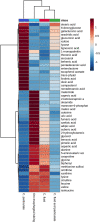Characterization of rumen microbiome and metabolome from oro-esophageal tubing and rumen cannula in Holstein dairy cows
- PMID: 37041192
- PMCID: PMC10090163
- DOI: 10.1038/s41598-023-33067-5
Characterization of rumen microbiome and metabolome from oro-esophageal tubing and rumen cannula in Holstein dairy cows
Abstract
Less invasive rumen sampling methods, such as oro-esophageal tubing, became widely popular for exploring the rumen microbiome and metabolome. However, it remains unclear if such methods represent well the rumen contents from the rumen cannula technique. Herein, we characterized the microbiome and metabolome in the rumen content collected by an oro-esophageal tube and by rumen cannula in ten multiparous lactating Holstein cows. The 16S rRNA gene was amplified and sequenced using the Illumina MiSeq platform. Untargeted metabolome was characterized using gas chromatography of a time-of-flight mass spectrometer. Bacteroidetes, Firmicutes, and Proteobacteria were the top three most abundant phyla representing ~ 90% of all samples. Although the pH of oro-esophageal samples was greater than rumen cannula, we found no difference in alpha and beta-diversity among their microbiomes. The overall metabolome of oro-esophageal samples was slightly different from rumen cannula samples yet more closely related to the rumen cannula content as a whole, including its fluid and particulate fractions. Enrichment pathway analysis revealed a few differences between sampling methods, such as when evaluating unsaturated fatty acid pathways in the rumen. The results of the current study suggest that oro-esophageal sampling can be a proxy to screen the 16S rRNA rumen microbiome compared to the rumen cannula technique. The variation introduced by the 16S rRNA methodology may be mitigated by oro-esophageal sampling and the possibility of increasing experimental units for a more consistent representation of the overall microbial population. Studies should consider an under or over-representation of metabolites and specific metabolic pathways depending on the sampling method.
© 2023. The Author(s).
Conflict of interest statement
The authors declare no competing interests.
Figures







Similar articles
-
Bacterial communities in the rumen and feces of lactating Holstein dairy cows are not affected when fed reduced-fat dried distillers' grains with solubles.Animal. 2021 Jul;15(7):100281. doi: 10.1016/j.animal.2021.100281. Epub 2021 Jun 19. Animal. 2021. PMID: 34153603
-
Ruminal Degradation of Rumen-Protected Glucose Influences the Ruminal Microbiota and Metabolites in Early-Lactation Dairy Cows.Appl Environ Microbiol. 2021 Jan 4;87(2):e01908-20. doi: 10.1128/AEM.01908-20. Print 2021 Jan 4. Appl Environ Microbiol. 2021. PMID: 33097510 Free PMC article.
-
Rumen Bacterial Community Composition in Holstein and Jersey Cows Is Different under Same Dietary Condition and Is Not Affected by Sampling Method.Front Microbiol. 2016 Aug 3;7:1206. doi: 10.3389/fmicb.2016.01206. eCollection 2016. Front Microbiol. 2016. PMID: 27536291 Free PMC article.
-
Oro-ruminal sampling device and technique for rapid collection of rumen content and improved recovery of solid fractions for microbiome analysis.JDS Commun. 2024 May 31;5(6):563-567. doi: 10.3168/jdsc.2023-0536. eCollection 2024 Nov. JDS Commun. 2024. PMID: 39650028 Free PMC article.
-
Community structure of the metabolically active rumen bacterial and archaeal communities of dairy cows over the transition period.PLoS One. 2017 Nov 8;12(11):e0187858. doi: 10.1371/journal.pone.0187858. eCollection 2017. PLoS One. 2017. PMID: 29117259 Free PMC article.
Cited by
-
Effects of yeast culture supplementation on milk yield, rumen fermentation, metabolism, and bacterial composition in dairy goats.Front Vet Sci. 2024 Aug 7;11:1447238. doi: 10.3389/fvets.2024.1447238. eCollection 2024. Front Vet Sci. 2024. PMID: 39170629 Free PMC article.
-
Relationships among bacterial cell size, diversity, and taxonomy in rumen.Front Microbiol. 2024 Apr 2;15:1376994. doi: 10.3389/fmicb.2024.1376994. eCollection 2024. Front Microbiol. 2024. PMID: 38628864 Free PMC article.
-
The Effects of Animal, Collection Time, and Interval on the Microbiota Structure, Metabolism, and Degradative Potential of Rumen Fluid Inoculum Collected by Esophageal Probe from Hay-Fed Cows.Animals (Basel). 2024 Dec 9;14(23):3547. doi: 10.3390/ani14233547. Animals (Basel). 2024. PMID: 39682512 Free PMC article.
-
Herbal formula alleviates heat stress by improving physiological and biochemical attributes and modulating the rumen microbiome in dairy cows.Front Vet Sci. 2025 Mar 7;12:1558856. doi: 10.3389/fvets.2025.1558856. eCollection 2025. Front Vet Sci. 2025. PMID: 40125321 Free PMC article.
-
Utility of dairy microbiome as a tool for authentication and traceability.Open Life Sci. 2024 Oct 30;19(1):20220983. doi: 10.1515/biol-2022-0983. eCollection 2024. Open Life Sci. 2024. PMID: 39479351 Free PMC article. Review.
References
-
- Hungate RE. The Rumen and Its Microbes. Academic Press; 1966.
-
- Russell, J. B. Rumen Microbiology and Its Role in Ruminant Nutrition (Agricultural Research Service, United States Department of Agriculture (ARS-USDA), 2022).
-
- Saleem F, Bouatra S, Guo AC, Psychogios N, Mandal R, Dunn SM, Ametaj BN, Wishart DS. The bovine ruminal fluid metabolome. Metabolomics. 2013;9:360–378. doi: 10.1007/s11306-012-0458-9. - DOI

